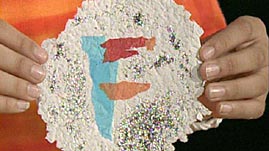Teachers' Domain - Digital Media for the Classroom and Professional Development
User: Preview


Source: ZOOM
Recent Environmental Protection Agency studies have shown that 0.9 metric tons (one ton) of recycled paper saves 17 trees, 26,500 liters (7000 gallons) of water, 27 kilograms (60 pounds) of pollution, 2.5 cubic meters (3.3 cubic yards) of landfill space, and enough energy to power the average American home for six months. In this video segment adapted from ZOOM, cast members demonstrate how something that might otherwise be discarded, such as newspaper, can be recycled to create a functional or even beneficial new product.
Many of Earth's natural resources, including fossil fuels and minerals, are nonrenewable and cannot readily be replaced. Fossil fuels, for example, form over periods of millions of years — much more slowly than the rate at which humans consume them. Other resources, such as forests, are considered renewable resources; provided they are managed properly and not over-harvested, new forests can grow in a relatively short amount of time.
By adopting an easy-to-remember three-pronged strategy known as the 3 Rs — Reduce, Reuse, and Recycle — societies such as ours can conserve renewable natural resources for future generations. First, we can reduce the volume of goods we buy or the energy we use by purchasing durable, long-lasting products, limiting our use of electricity and gasoline, and refusing to purchase over-packaged goods. Second, we can reuse items that we might otherwise discard. For example, we can purchase rechargeable batteries instead of single-use varieties, repair broken objects instead of throwing them away, and donate unwanted clothing and equipment to charities for reuse by someone else.
The third prong of this resource conservation strategy — and perhaps the most well-known and successful one — is to recycle. Recycling turns materials that would otherwise become waste into useful new objects, thus saving energy and lessening the demand for natural resources such as forest products. For example, recycled corrugated cardboard boxes can be made into cereal boxes, recycled plastic soda bottles can be made into warm, comfortable fleece jackets, and crushed glass and ground-up tires can replace some of the gravel and sand used for road-surfacing material. In nearly all cases, producing goods from recycled materials requires significantly less energy than creating new goods from scratch. Also, by choosing to buy recycled products now, people create an economic incentive for recyclable materials to be collected, manufactured, and marketed as new products in the future.
In the U.S., community recycling programs, which include curbside pickup, drop-off centers, and bottle and can redemption machines, divert tens of millions of tons of solid waste each year from landfills and incinerators. Still, there is ample room for improvement: less than one third of the solid waste generated by individuals, businesses, and government agencies gets recycled.
 Loading Standards
Loading Standards Teachers' Domain is proud to be a Pathways portal to the National Science Digital Library.
Teachers' Domain is proud to be a Pathways portal to the National Science Digital Library.
